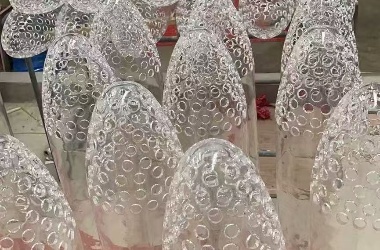With continuous improvements in hydrochloric acid production technology and increasing market demands for higher quality hydrochloric acid – particularly the need for high-purity HCl in ion-exchange membrane caustic soda production – the energy-efficient “three-in-one” furnace method for high-purity HCl has gained widespread adoption. However, one critical component – the quartz burner tube – suffers from relatively short service life, with frequent failures posing a significant operational challenge.
Quartz tube failures lead to production shutdowns that not only reduce HCl output but also disrupt the entire chlorine system, creating imbalances that affect production efficiency and chlorine recovery rates. Moreover, as quartz tubes are expensive components, frequent replacements significantly increase maintenance costs and reduce production profitability. Therefore, proper utilization of quartz tubes to extend their service life has become an urgent issue requiring resolution. Based on extensive operational experience with three-in-one furnaces, this paper analyzes the primary causes of quartz tube failures and proposes corresponding preventive measures.
1. Damage Caused by Hydrogen Stream Impurities
Ineffective hydrogen treatment can result in excessive moisture carryover. Water vapor in hydrogen readily condenses into droplets, leading to high moisture content. When these droplets enter the three-in-one furnace and contact the extremely hot quartz tubes (exceeding 2000°C), thermal shock causes tube fracturing. The entrained water contains trace inorganic salts (primarily NaCl, NaOH, Na₂CO₃, and NaHCO₃). As these saline droplets evaporate on the quartz surface, salt deposits accumulate on the tube walls. The differing thermal expansion coefficients between these deposits and quartz glass create mechanical stresses that damage the tubes at high temperatures. Additionally, deposit buildup obstructs gas (flame) flow, causing flame rollover that may damage graphite furnace components through overheating, potentially leading to tube detachment or crushing. Furthermore, high-temperature salt corrosion produces white ceramic-like formations that flake off in layers, further reducing tube lifespan.
Solutions for excessive hydrogen moisture/salt content:
Enhanced cooling/drying:
- Increase spray water flow in hydrogen scrubbers
- Improve post-compression cooling:
a) Expand heat exchange area in hydrogen separator/coolers
b) Increase cooling water flow rate
c) Lower cooling water inlet temperature - Advanced cooling options: Our company successfully uses lithium bromide chiller systems (5°C coolant) for summer hydrogen cooling
- Install hydrogen buffer tanks at pipeline high points with condensate collection/drainage
Regular descaling (frequency based on deposit accumulation rate):
- For severe scaling: Pre-treatment with 30% HCl soak followed by water rinse facilitates tube removal
2. Impact of Chlorine Stream Impurities
Despite chlorine treatment, ineffective mist elimination results in significant acid mist carryover. This is particularly severe when using tail gas from liquid chlorine production as feedstock, where residual acid droplets accumulate in liquefiers. These mists react with iron piping to form viscous iron sulfate deposits that similarly damage quartz tubes when sintered.
Mitigation measures:
- Secondary purification before furnace entry
- Installation of cost-effective silicone oil/glass fiber mist eliminators in chlorine buffer tanks (demonstrated effectiveness in our facility)
3. Startup/Shutdown Damage
Operational risks:
- Cold starts: Condensation on tubes causes explosive vaporization during ignition
- Rapid loading: Thermal shock from heating rates exceeding 50°C/min
- Improper shutdown: Immediate vacuum application after flameout causes quenching fractures
Best practices:
- Pre-ignition: Thorough tube drying with lint-free wipes
- Controlled ramp-up: Gradual loading (<20% capacity increase/hour)
- Proper cooldown: Maintain furnace temperature >100°C before vacuum activation
- Winter operations: Special attention to thermal management
4. Installation-Related Failures
Critical installation parameters:
| Factor | Specification | Consequences of Deviation |
| Tube-graphite clearance | 1.5±0.2 mm | <1.3mm: Crushing; >1.7mm: Detachment |
| Alignment | ≤0.5° axial tilt | Uneven heating → fracture |
Installation guidelines:
- Use furnace-matched quartz tubes
- Secure proper mounting without play
- Employ laser alignment tools for precision
5. Operational Abnormalities
Explosion prevention measures:
- Maintain optimal H₂:Cl₂ ratio (1.05-1.10)
- Limit tail gas O₂ content <4%
- Weekly pressure integrity tests (<0.5% drop/24h)
- Strategic installation of 0.3 MPa rupture discs
- Strict process controls:
- H₂ purity ≥98%
- Cl₂ H₂ content ≤3% (especially for tail gas feed)
6. Manufacturing Defects
Quality control requirements:
- Dimensional:
- Wall thickness uniformity: ±0.1mm (ultrasonic verification)
- Flange flatness: ≤0.05mm warp (laser measurement)
- Material:
- CTE consistency <0.6×10⁻⁶/°C
- No UV-detectable microcracks
- Homogeneous crystalline structure
7. Results and Conclusion
Implementation of these measures at our facility has yielded significant improvements:
| Metric | Before | After | Improvement |
| Average service life | 1-2 months | 4-6 months | 200-300% |
| Annual replacements | 12 | 3 | 75% reduction |
| Related downtime | 48 hours | 12 hours | 75% reduction |
| Annual cost savings | – | $27,600* | – |
*Includes 18,000indirectreplacementcostsand9,600 in production losses
Key success factors:
- Comprehensive impurity control systems
- Optimized thermal management protocols
- Precision installation practices
- Rigorous quality assurance for replacement components
These operational enhancements have substantially improved production stability while delivering measurable economic benefits.
